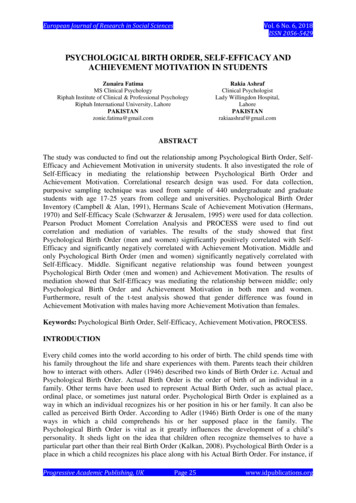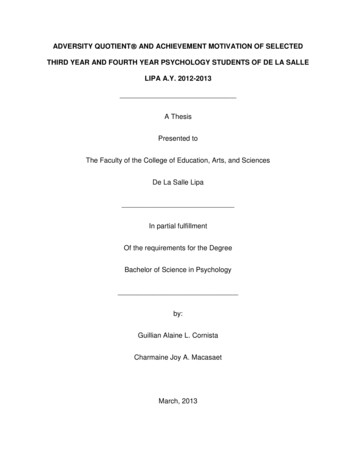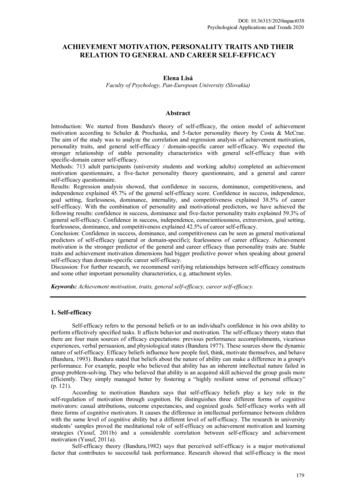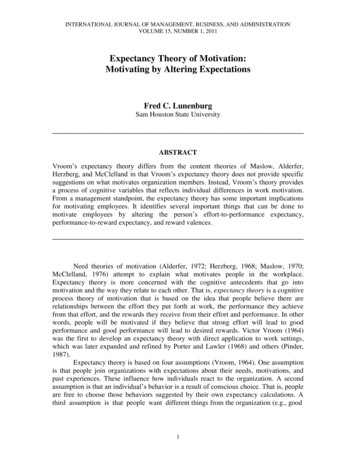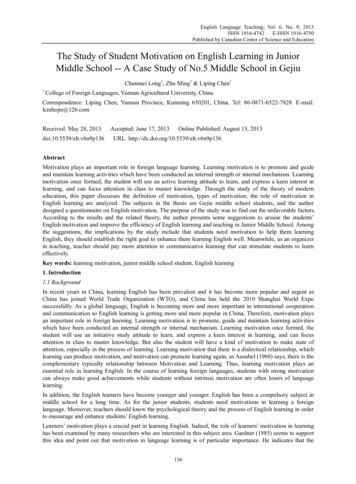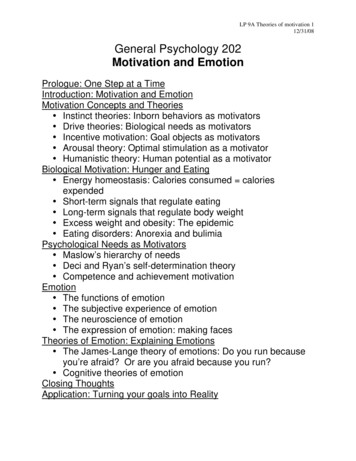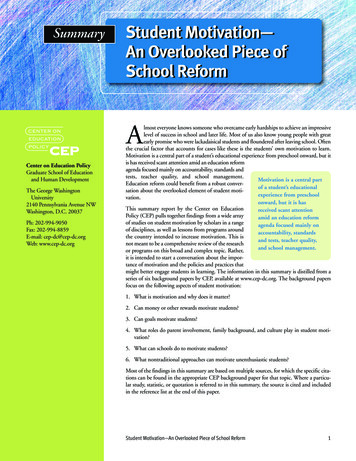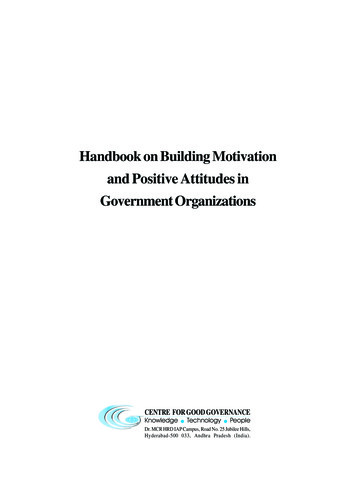
Transcription
Handbook on Building Motivationand Positive Attitudes inGovernment OrganizationsCENTRE FOR GOOD GOVERNANCEKnowledgelTechnologylPeopleDr. MCR HRD IAP Campus, Road No. 25 Jubilee Hills,Hyderabad-500 033, Andhra Pradesh (India).
Handbook on Building Motivation and Positive Attitudes in Government OrganizationsNo part of this book may be reproduced in any form without permission in writing from the publisher,except by a reviewer or a research scholar who may quote brief passages in a review in a magazineor a newspaper or for research purposes as the case may be.Copyright CGG 2004Printed and published by the Director General & Executive Director, Centre for Good Governance,Dr MCR HRD IAP Campus, Road No. 25, Jubilee Hills, Hyderabad 500 033.
Handbook on Building Motivation and Positive Attitudes in Government OrganizationsContentsSL.NO. TITLEPAGE NO.A Brief Note on the Handbook1-2A Short Quiz on Motivation3-5SECTION 1: SELF - MOTIVATION1.1.Desire to Excel in Whatever we Do7-81.2.Building Positive Orientation8-91.3.An Experimental Study1.4.Choosing to Make a Difference in Zone of Influence1010 - 11SECTION 2: INDIVIDUAL ATTITUDES2.1.What Motivation Theories tell us aboutIndividual Attitudes?12 - 132.2.Attitudes Needed for Good Governance142.3.Attitude and Motivation2.4.Attitudes in Traditional Societies2.5.Challenge of Attitude Change18 - 202.6.Inability to Satisfy Employee Needs: Myth or Reality?21 - 2215 -1617SECTION 3: INTERPERSONAL AND TEAM EFFECTIVENESS3.1.Enhancing the Quality of ourInterpersonal Effectiveness23 - 243.2.Improving your Communication Effectiveness25 - 273.3.Effective Listening27 - 303.4.The Magic of Teamwork31 - 333.5.Improving Interpersonal and Team Effectiveness34 - 373.6.Tips for Supervisors38 - 41SECTION 4: GOALS, ROLES AND RECOGNITION4.1.Goal Setting43 - 474.2.Job Design48 - 514.3.Recognition and Rewards52 - 55SECTION 5: IMPROVING WORK ENVIRONMENT5.1.Work Climate56 - 615.2.Organizational Culture62 - 685.3.Principles of 5 S Management69 - 73Some Closing Comments74 - 76CENTRE FOR GOOD GOVERNANCEKnowledge l Technology l People
Handbook on BuildingMotivationAccountabilityin PublicWorks and Positive Attitudes in Government Organizations
Handbook on Building Motivation and Positive Attitudes in Government OrganizationsA BRIEF NOTE ON THE HANDBOOKThis handbook has been put together to help you address an important question.How to build motivation and develop positive attitude for work amonggovernment employees at different levels? It includes 'how to' guidelines,checklists, useful tips for practitioners, short case illustrations, questionnairesand inventories on practical aspects of motivation. It is expected that thishandbook would be used as the basis for conducting future programmes onthis theme, as compilation of useful guidelines for officials of the governmentand as a resource book for any one interested in bringing a positive change inthe motivational climate of government organizations.It is widely felt that government organizations have been largely ineffective inmeeting the challenges facing the state. Government employees are generallyperceived to be indifferent to the needs and aspirations of the people and resistantto any reform effort. Though sporadic efforts are made to bring positive changesin different aspects of the governmental functioning, these tend to end up as amere 'flash in the pan' in the absence of employee motivation to invest time,energy and effort in persisting with new approaches and sustaining resultorientation. It is, therefore, not a surprise that citizens feel disenchanted withand alienated from government organizations and government officials.To bring about a meaningful reform, change leaders and change consultantsmay first go through extensive consultations, thoughtful diagnosis of issues anddevelopment of sound recommendations. But when they come to the stage ofactually implementing change, they tend to run into the minefield of poorCENTRE FOR GOOD GOVERNANCEKnowledge Technology People
Handbook on Building Motivation and Positive Attitudes in Government Organizationsmotivation with unerring regularity. Unfortunately, there is a great deal ofhelplessness in dealing with this problem. The common lament is that resistanceis often passive and change efforts get quietly and unceremoniously buried inthe quicksand of collective indifference and apathy.As motivation is such a key issue, this handbook has made a careful review ofthe management theory and management practice to derive insights that aremost relevant for government organizations. We have tried to compile relevantlearning resources like tips, checklists, inventories and short case examples tohelp managers and leaders create a positive environment in governmentorganizations. It is expected that this manual would serve as a basis for futureprogrammes on this theme; it would help government officials at senior andmiddle levels by providing guidelines for action; and it would also become auseful reference for any one interested in bringing about positive changes ingovernment organizations.As with other such handbooks, we have drawn on a number of sources to offeryou a set of essential professional tools in one place for ready reference. Thereare several tools, techniques and tips in management and leadership literatureand we have picked those that we believe are likely to be the most useful foryour work. As you keep applying the techniques to real-life situations to bringabout real improvements, you would be able to thereby expand and refine yourtool kit.This manual covers different aspects of how government officials can motivatethose who report to them. As we all know, motivation flows from a variety offactors. It depends on whether work goals are set in a participatory manner,2
Handbook on Building Motivation and Positive Attitudes in Government Organizationswhether the unit's challenges or the 'big picture' are properly clarified toemployees through effective superior-subordinate and team communication,whether good performance is visibly recognized, whether the senior people createa caring culture and so on. We present a set of tools to help team leaders examinethe level of motivation in the work group, what contributes to making it high orlow and what can be done to improve it.As a part of this manual, we have also discussed the magic of self-motivation.Our success as individuals does not merely flow from our analytical and specialistskills. It is not the brightest individuals (in terms of IQ) who are the mostsuccessful. The 'will' factor is a critical parameter for success. 'Will' refers to howoptimistic, determined and enthusiastic we are as individuals about achievingresults. As the old adage goes, 'where there is a will, there is a way'. So this partof the manual is designed to help individuals reflect on how they can strengthentheir proclivity to pursue goals with energy, persistence and enthusiasm.We are all aware that a powerful way of learning is by "doing". Effective leadersconstantly learn through active experimentation.A journey of a thousand milesFrom this perspective, your learning of a certain begins with a single step.- Chinese Proverbtechnique would be really complete only whenyou have used that technique after tailoring it tothe specific circumstances you face and achieved the results that you had aspiredfor.We wish you a lot of excitement of leading your unit to greater heights inperformance, responsiveness and learning!CENTRE FOR GOOD GOVERNANCEKnowledge Technology People
Handbook on Building Motivation and Positive Attitudes in Government OrganizationsA SHORT QUIZ ON MOTIVATIONBefore we begin the manual, we present you a short quiz on some aspects ofmotivation. We hope you find the questions interesting. Before you check theanswers at the end, please do give your responses to each question. The quizwould be able to tell you how much your understanding matches with whatexperts on motivation theory and practice have to say about the subject. Hereare the questions with the options at the end of each question.1.In reality, employee motivation is:a. Less important than it once was.b. A critical key to performance.c. Not something that can be “managed.”2.A key to motivation is:a. Giving employees everything they want.b. Making “undesirable” behavior harder to perform.c. Making “desirable” behavior easier to perform.3. Generally, your smartest approach with employees is to:a. Tell them what you expect and then leave them alone.b. Let them guess what you want, then correct as required.c. Clarify expectations and then provide feedback.4.The most powerful motivations for change are:a. Need or opportunity.b. Discomfort or pain.c. Warnings from the Human Resources department.4
Handbook on Building Motivation and Positive Attitudes in Government Organizations5.Employees tend to be motivated most by:a. Pay and benefits.b. Job security.c. Interesting work.6.The best time to deal with employee behavior is:a. Immediately.b. At the next performance appraisal.c. Only when the employee asks for help.7.Small token gifts and verbal recognition:a. Can help motivate any employee.b. Appropriate only with the less educated.c. Will reinforce good performance only if they are presented publicly.8.The most common error in trying to motivate employees is:a. Rewarding with too little, too late.b. Making assumptions about what motivates.c. Focusing only on the poor performers.9.The best thing a manager can do to build a high performance culture is:a. Say the right thing and genuinely mean it.b. Be an example to everyone on the job.c. Show appreciation.10. Being good at motivation and reinforcement primarily requires:a. Good listening and observation skills.b. A willingness to understand other’s views.c. A background in psychology or a degree in human resource development.CENTRE FOR GOOD GOVERNANCEKnowledge Technology People
Handbook on Building Motivation and Positive Attitudes in Government OrganizationsANSWERS:Each correct answer is worth 10 points1. b. In today’s economy, understanding and skill in motivating employees aremore important than ever. With easy access to information, they are more awareof what they may perceive as “greener pastures” in other organizations.2. both b and c. Motivation must be planned on both the strategic and tacticallevels. Make the “old” behavior less attractive and more difficult while makingthe “new” behavior both attractive and easier. Remove rewards for the oldbehavior you don’t want and add rewards for the new behavior you seek. As thesaying goes, either you reinforce the behaviors of the desired change or youreinforce the behaviors of the status quo.3. c. Friendly clarity is the lubricant for smooth relationships. Clarify on whatyou expect of others and ask for their expectations of you (even if you’re the“boss”). Then build feedback loops into the situation so that all parties feel “safe”in speaking up.4. b. Discomfort and pain tend to provide the most compelling motivation forchange. That’s not to suggest that you create pain so that people will change.But you need to help people understand the pain of not changing. That meansproviding strong reasons or case for action – in the frame of reference of thepeople you’re trying to influence. Fear of the unknown keeps many people frommaking changes. Chalk up another point for clarity.5. c. Study after study shows that “interesting work” tops the list of things thatemployees claim to be most motivating to them. That’s followed by“appreciation,” “being part of a team,” “job security” and then fifth on the list,“good wages.” Interestingly, when managers are asked to list what they thinkmotivates employees, they place money as number one on the list andappreciation a distant eighth. This disconnect is a primary cause of eroding loyaltyin the work place.6. a. When your three year-old either misbehaves or does something good, youdon’t say “Raju, let’s take that up at your next quarterly review.” You offercorrection or praise on the spot. The same principle applies to adults. Practice6
Handbook on Building Motivation and Positive Attitudes in Government Organizationsthe “PICNIC” approach to reinforcement. For behavior you want, providereinforcement that is Positive, Immediate and Certain. For behavior you don’twant provide reinforcement that’s Negative, Immediate and Certain. In highperformance organizations, everyone is clear about what they stand for and whatthey won’t stand for.7. a. As long as they have relevant symbolic meaning, even very simple itemscan have strong reinforcement value. The “token” can be absolutely anything aslong as it is valued by the recipient. Remember that “value” does not necessarilyhave anything to do with money. And don’t forget the importance of verbalrecognition for the good work done. It shows the employee that you watch hisperformance and that you care.8. b. Many managers wrongly assume that they know what the employees want.Case after case, they have been proved wrong. Always take the time to ask whatwould be a good reward. The answer may surprise you.9. c. Remember the EMR formula for success: Express, Model, Reinforce. Firstyou express (talk about) the values or behavior you treasure. Then youconsistently model it in your own actions. Then you reinforce (reward) it inothers. Modeling is twice as effective as expressing and reinforcing is at leastthree times as effective.10. both a and b. There’s really nothing complicated about motivating people todo their best. Simply listen to and observe your people very carefully and selectyour strategies and tactics from their frame of reference. It’s amazing how easyand inexpensive good reinforcement can be.Quiz ScoringYour score:80 – 100 You scored high and that’s good. But don’t get complacent. Goodreinforcement management requires constant focus.60 – 70 Next time you face an opportunity to reinforce (which is no doubt everyday) try these ideas.Below 60 Motivation troubles in your organization? Read this handbook carefullyand practice the tips given in the manual.CENTRE FOR GOOD GOVERNANCEKnowledge Technology People
Handbook on Building Motivation and Positive Attitudes in Government OrganizationsSECTION 1SELF-MOTIVATIONMany people believe that ultimately all motivation boils down to self-motivation. Anindividual may be offered attractive incentives; but they will only help the person todecide to get motivated. We know that, with or without external incentives andinducements, some individuals remain highly motivated and some stay poorly motivated.Thus, the main spring of motivation is from within. As the adage goes, “You can lead ahorse to water but you can’t make it drink”.Most of us have heard the parable of three stone cutters. When asked what he isdoing, the first stone cutter states that he is leading a miserable and meaninglessexistence of cutting stone, hour after hour and day after day, without respite. Thesecond stone cutter has a different reply to the same question. He points out thathe is the bread winner for his family and he is cutting stones to earn money. Butwhen asked the same question, the third stone cutter has a completely differentresponse. With a glow of pride and satisfaction on his face, he says that he is partof the team contributing to the building of a great monument.What would be the implications of these different perspectives for the involvementand commitment of the three individuals? What is the likely impact of theseperceptions on the quality that the three individuals are likely to produce? Whichemployee is likely to experience greater job satisfaction and fulfillment and who8
Handbook on Building Motivation and Positive Attitudes in Government Organizationsis likely to grow and develop, both as a person and as an employee? The answersto these queries are quite obvious. The parable reflects the saying: “The real voyageof discovery consists not in seeking new landscapes but in having new eyes”.Motivated people accomplish far more. They enjoy a more interesting andfulfilling life. Thus, being motivated is in the enlightened self-interest ofindividuals. Even if we forget about individual and organizational performancefor a minute, when persons are inspired, they would have richer work and lifeexperiences. In that sense, being self-motivated is infinitely preferable to beingapathetic.Organizations value the people who are willing and committed. They runeffectively because there are employees whoMotivation is like fire – unlesshave the drive and determination to see the you keep adding fuel to it, it dies.job through. These are the people who will ‘go the extra mile’ to achieve thedesired results. Even if the organization fails to reward such individuals, theindividuals themselves would enjoy the benefit of growing as persons and asprofessionals.People who are self-motivated know what is important to them. They know whatthey want out of life and plan the steps they need to take to achieve their goals.They have long-term and medium-term goals as well as short-term objectives.They don’t settle for the path of least resistance or a quick-fix. Their focus onobjectives and end results help them deal with momentary setbacks and hurdles.CENTRE FOR GOOD GOVERNANCEKnowledge Technology People
Handbook on Building Motivation and Positive Attitudes in Government OrganizationsWhen we deal with the subject of self-motivation, we would confront numerousquestions: How do we develop optimism and positive orientation? How do wetrain ourselves to remain hopeful and positive when dealing with problems anddifficult situations? How do we retain our power of choosing our response withoutsuccumbing to the situational pressures? This section deals with such questionsand presents some guidelines for building self-motivation as a viable remedialmeasure.10
Handbook on Building Motivation and Positive Attitudes in Government Organizations1.1 DESIRE TO EXCEL IN WHATEVER WE DOSelf Motivation to achieve standards of excellence does not necessarily enhancethe quality of individual and organizational performance. For the individualsinvolved in pursuit of excellence, there is the added benefit of a meaningful, richand full life. Such individuals develop keen interest and enjoy their work. Whenindividuals are excited and passionate about their interests, they feel energizedand motivated. They experience strong commitment to their work, organization,professional interests and their stakeholders.Some individuals are constantly involved in developing their abilities, capabilitiesand talents. Experience is inevitable; learning is not. All employees have accessto the same opportunities. But it is only the “Nothing great is ever achievedself-motivated employees, who learn, develop without enthusiasm.”- Ralph Waldo Emersonand successfully realize their potential. Thisfactor is an important element in providing the individuals’ contentment andfulfillment.People who are committed to the standards of excellence: Have good understanding of where they want to go, why do they wantto reach there and how they are progressing towards those goals. They are highly result-oriented and strive to meet their objectives andstandards of excellence in whatever they do. They constantly set challenging goals for themselves and take calculatedrisks to achieve those goals. They constantly seek to improve their performance levels.CENTRE FOR GOOD GOVERNANCEKnowledge Technology People
Handbook on Building Motivation and Positive Attitudes in Government OrganizationsLet us now look at the following case study, which deals with how two differentsets of government officials responded to the same situation in quite differentways, and therefore ended up achieving dramatically different results.A TALE OF TWO RESPONSES – CASE STUDYAccording to news reports, in the elections held in April 2004, two sets ofofficials exhibited two very different behaviour patterns in managing theelection process. In certain villages in a district, the panchayat secretariesmade better arrangements, particularly with regard to issuance of residencecertificate to voters as an alternative to photo identity card.In these villages, having an election photo identity card was not at all acriterion to cast votes. The village secretaries organized camps at all pollingstations to issue residence certificates to needy voters. Since many ruralpeople were not aware of the election photo identity card or its alternative,they turned up at the polling stations only with a voter slip. For them,village secretaries and other staff extended help by issuing them residencecertificates in just two minutes. When enquired about the criteria forissuing residence certificates, the village secretaries said that having namein the voters’ list was enough. The procedure the village secretaries adoptedwas very simple. They asked political parties to identify the voter whomay not be genuine and raise their objections on issuing residencecertificates to them.Further, a register was maintained to collect address and thumb impressionof the recipients on certificates as per the election commission guidelines.In every village, over 200 certificates were issued, following which goodturnout of voters was maintained. In these villages, large tents were erectedto provide drinking water at polling stations by concerned gram panchayatto save voters from heat wave and sun stroke.12
Handbook on Building Motivation and Positive Attitudes in Government OrganizationsBut in certain other areas, those who could not bring the alternative to thephoto identity card left without casting their vote as none of the concernedofficers were there at the polling stations to issue residence certificates.Large numbers of such voters whose names were there in the list could notcast their vote due to absence of election photo identity card or any otheralternative. When contacted, the officials merely blamed the voters saying“they should have taken the initiative at the right time. What can we do?”Clearly, these officials had not anticipated and planned for such aneventuality. As a result, a large number of genuine voters lost theopportunity to participate in the democratic process.Now, what does this short case convey to you?From the above case study, certain clear suggestions emerge for improving yourcapacity to strive to realize your potential: Strive to look at your role from the eyes of your internal/ externalcustomers or citizens. What kind of a service would delight them? Whatdo you have to do to provide them such service? Constantly seek to focus your time and energy on the few importantpriorities that are critical for your effectiveness. Don’t get caught up inday-to-day routine things and neglect important long-term priorities. Try to set challenging and meaningful goals to motivate yourself. Do not give up hope and optimism when you face hurdles and whenthings become difficult. View crises as opportunities to improve yourself rather than viewingthem as pitfalls. Constantly seek to develop your own skills by earmarking sufficienttime. Do not postpone important things. Act immediately instead of waitingtill the last minute. Ensure that you complete the things that you start. Make it a habit to reward yourself after you have accomplished aworthwhile goal.CENTRE FOR GOOD GOVERNANCEKnowledge Technology People
Handbook on Building Motivation and Positive Attitudes in Government Organizations1.2 BUILDING POSITIVE ORIENTATIONThe ability to look at the brighter side of life and to maintain a positive approachin the face of adversity is what is known as positive orientation. It is persistencein pursuing goals despite obstacles and setbacks.Positive orientation helps people to cope up with problems and drive awaydepression. There is a strong connection Start by doing what is necessary,between one’s degree of positive orientation then what is possible, and suddenlyand one’s ability to cope up with the problems you are doing the impossible.effectively. Positive orientation plays an- St. Francis of Assisiimportant role in overall self-motivation and is a very important factor in reachinggoals and coping with stress.Many studies have examined the characteristics of people having positiveorientation. Studies found that people with positive orientation, display thefollowing behaviors: Constantly look at the brighter side of life. They are confident of themselves and operate with hope rather thanfear of failure. They are self-motivated even when things get difficult. They quickly bounce back from defeats. They persist with their efforts to achieve goals and objectives, despitehurdles and setbacks.14
Handbook on Building Motivation and Positive Attitudes in Government OrganizationsHow can we enhance our positive orientation? The following suggestions emergefrom the approach of positive individuals: Make constant efforts to look at the brighter side of life. Try being more hopeful when dealing with problems and difficultsituations. Make an effort to maintain a more Don’t allow pessimistic thoughts to take over.“An open ear is the onlypositive attitude, even when the going believable sign of an open heart.”- David Augsburgergets tough.In addition to the above practices, we should also do some introspection on thequestion of whether we belong to the category of “status-quo” persons or whetherwe are among the “innovators”?A status-quo person generally exhibits the following behaviors: Simply passes his time Does not plan or allocate any time for development projects Works simply to maintain the status quo, avoid problems and criticismand solve problems in the short term Is usually controlled by external influences: telephone calls, mails,interruptions etc.CENTRE FOR GOOD GOVERNANCEKnowledge Technology People
Handbook on Building Motivation and Positive Attitudes in Government OrganizationsSimilarly, an innovator would exhibit the following behaviors: Effectively carries out current tasks. Makes conscious efforts to allocate time for self-development. Ensures that he spends sufficient time everyday on important priorities He is guided by the goals he had set for the future, rather than gettingcaught up in fire-fighting. He maintains self-discipline to avoid a short term benefit for the sake ofachieving important long term results.Fritz Kreisle, the great violinist, was onceasked, “How do you play so well? Is itluck?” He replied, “It is practice. If I don’tpractice for a month, the audience can tellthe difference. If I don’t practice for a week,my wife can tell the difference. If I don’tpractice for a day, I can tell16
Handbook on Building Motivation and Positive Attitudes in Government Organizations1.3 AN EXPERIMENTAL STUDYAt a large university, a group of four-year-old children were given aninteresting test. Each child was given a sweet. But each child was alsogiven two optionsOption 1: They could choose to eat the sweet immediately. In this case,they would only get one sweet.Options 2: The researchers will leave the room and come back in half-anhour. If the children have still not eaten the sweet after those 30 minutes,they would get two sweets instead of one.Unknown to the children, their behaviour was video-taped by hiddencameras. There were interesting differences in the behaviour of differentchildren. Many chose to eat the sweet immediately. However, there weresome, who overcame the temptation and waited for 30 minutes. To keeptheir minds away from the sweet, they sang nursery rhymes, ran aroundthe room, turned their head away from the sweet, so that they could gettwo instead of one.These children were tracked for the next fifteen years. Interestingly, dramaticdifferences were observed between the two groups of children. Thechildren, who had resisted the temptation, turned out to be more effectiveat everything they did. They were more confident and more successful.The remaining children, who had eaten the sweet immediately, had a fewerof these qualities.Thus, though the experiment itself seemed to be rather simple, it had predictedCENTRE FOR GOOD GOVERNANCEKnowledge Technology People
Handbook on Building Motivation and Positive Attitudes in Government Organizationscertain important elements of the future. What do you think accounts for thedramatic differences in the latter performance of these two groups of children?These dramatic differences could be attributed to the ability of some children topostpone an immediate pleasure for the sake of a longer term goal. In other words,the following important ideas stand out from the above interesting research: To achieve a long term result, it is sometimes necessary to postpone animmediate impulse or pleasure. When you want to achieve your goal, you should be able to ignoredistractions and overcome obstacles. Do not procrastinate important things. Do not wait until the last minuteto act. Allocate time to develop yourself.A man is a hero not because he is braverthan anyone else, but because he isbrave for ten minutes longer.- Ralph Waldo Emerson18
Handbook on Building Motivation and Positive Attitudes in Government Organizations1.4 CHOOSING TO MAKE A DIFFERENCEIN ZONE OF INFLUENCETHE PARABLE OF STARFISHA man once observed someone from a distance early in the morning on abeach. The young man seemed to be bending down, picking up somethingand throwing it into the ocean. He seemed to be doing it continuouslyfor quite some time.Out of curiosity, the man went closer to see what was happening. Thenhe asked the young man as to what he was doing. The young man repliedthat a number of starfishes had been washed over to the beach. As the Sunwas rising and the water level was receding, the starfishes were likely to dieif they were not thrown back into the ocean.The observer laughed at this and said to the young man, “there are milesa
Handbook on Building Motivation and Positive Attitudes in Government Organizations SL.NO. TITLE PAGE NO. A Brief Note on the Handbook 1 - 2 A Short Quiz on Motivation 3 - 5 SECTION 1: SELF - MOTIVATION 1.1. Desire to Excel in Whatever we Do 7 - 8 1.2. Building Positive Orientation 8 - 9 1.3. An E xperimental Study 10 1.4.
